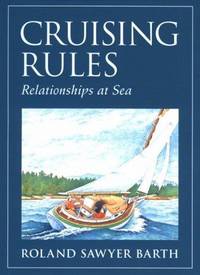Book Reviews From 1998
- Crusing Rules, by Roland S. Barth
- Dragged Aboard, by Don Casey
- Cruising 101: Avoiding the Pitfalls of Paradise, by Amy Sullivan and Kevin Donnelly
- Illustrated Dictionary of Boating Terms: 2000 Essential Terms for Sailors and Powerboaters, by John Rousmaniere
Cruising Rules
by Roland S. Barth. $12.95 Reviewed by Dan Smith Good Old Boat, June, 1998

Sailors’ libraries are filled with every conceivable subject matter from dinghies to clipper ships – alcohol stoves to diesel engines, etc. but missing is a book to explain personal relationships at sea – or how to make a peaceful cruising passage with mate and/or crew members.
Roland S. Barth, a retired Harvard professor, has assembled a melange of mishaps on board and off, which actually occurred during his ownership of a vintage wooden Friendship sloop. These misadventures prompted Barth to discover solutions: “Rules for personal behavior at sea making it possible to stay on speaking, even friendly terms while confined in close quarters for an indefinite period.”
Cruising Rules is presented in an entertaining, humorous manner with the academic skills of a lifelong educator. Beautifully illustrated, the book is prefaced by the author’s reasons for writing about “relationships at sea.” It also contains a glossary of terms, a map of the Maine coastline, and a consolidated list of the 25 rules to be followed for compatibility and happiness on board.
Examples from the glossary:
- Dismasting – cataclysmic act by which a sailboat is transformed into merely a boat
- Winch handle – essential metallic, elbowlike appliance usually found (or lost) in mud at ocean’s bottom
I particularly enjoyed two of the cruising rules emerging from strained, onboard relationships:
Rule Number 6 – Non-discussibles may be discussed only within swimming distance of home port Rule Number 10 – The gods protect beginning sailors and fools – sometimes both at once
Statements by William F. Buckley, Jr., author of Atlantic High, and Roger Duncan, co-author of Cruising Guide to the New England Coast, provide evidence this book is a must-read for every sailor.
Editor’s note: We were also very impressed with Barth’s work, and will be presenting selected chapters in future issues of Good Old Boat magazine. Personal favorite rules, based on our experience, include:
Rule Number 2 – Any story worth telling is worth telling often. Rule Number 7 – The hand that holds the paintbrush determines the color.
Dragged Aboard
by Don Casey (W.W. Norton & Company, 1998, $27.50) Reviewed by Karen Larson, Minneapolis, Minn. Good Old Boat, September, 1998

Before we contacted Don Casey to invite him to get involved with our new magazine, we decided to take another look at his best-known book, This Old Boat. Unfortunately, our copy wasn’t with our other sailing books. We wracked our brains. Had we loaned it to another sailor? Was it on the boat? Where could it have gone? Just prior to ordering a second copy, Jerry found This Old Boat in a most telling place: nestled in a large box of sandpaper.
Don’s newest book, Dragged Aboard – A Cruising Guide for the Reluctant Mate, is just as valuable but could wind up stashed in a variety of areas within the boat: galley, head, medicine kit, stowed with provisions, nav/communications center, or on the bookshelf as a trusted friend.
This Old Boat is aimed at the do-it-yourself boater – usually, but not always, a male. Dragged Aboard is meant for the not-quite-so-enthusiastic partner of a sailor — usually, but not always, a female. In a personal and friendly conversation with this reluctant mate, Don debunks cruising myths and fears and highlights the joys and benefits of the cruising lifestyle.
Worried about storms? Don says, “Thunderstorms almost never give a well-found and wisely handled cruising boat more than a jostle and a wash, but finding yourself on a boat in the middle of a particularly boisterous boomer can still be frightening. This is a good time for perspective. Images of solidly anchored homes reduced to rubble by wind, flood, mud, and tremor parade regularly across the evening news. By comparison, a cruising boat is virtually immune to weather. A well-built boat is incredibly tough: the roof isn’t going to blow off, the windows won’t blow in, and 40 days of rain won’t even wet the rug.”
Pirates? “They’ve found easier pickings selling cars, filing lawsuits, or sitting on city commissions. You might encounter a pirate when you’re cruising — if you need a new battery or your refrigeration goes on the fritz – but he won’t be armed with anything more lethal than the barrel he’ll have you over.”
Danger? “There is a violent crime in this country every 17 seconds. Assaults happen every 28 seconds, a robbery every 51 seconds. If you live in an American city, and a drug addict breaks into your home and slashes you with a knife, don’t expect to write a book about it. Odds are the story won’t even make the newspaper. The sad truth is that Americans can go almost anywhere else in the world and be safer than they are in their own neighborhoods.”
Cramped quarters? “If you have a nice house ashore, aren’t you certain to be less comfortable moving into a space smaller than your bedroom? The short answer is yes, but it isn’t the whole answer The cruising life may be less comfortable, but it is more luxurious. When was the last time you slept until noon? When have you spent an entire day with a good book? Do you know what it’s like to float for hours in warm, emerald waters? Do you know how wonderful bread is fresh from the oven? Is there a better combination than shade, breeze, food, and friends? How often do you toast the blush of sunset? Rare is the cruising day that isn’t, on balance, better than any day at the office.”
Don brings honesty and insight into conversations about getting along with your partner in a small space, making a boat a home (with a focus on accommodations, ventilation, lighting, comfortable seating, easy care fabrics), what to take and how to store it, stocking up (good tips for figuring out how much food to take along), staying in touch with folks at home, health and first aid, protecting your skin from the elements, cruising with kids, cleanliness aboard, and more.
If you’re afraid of misplacing your copy of this book (it could wind up anywhere, you know!) perhaps you’ll want several. The book was published by W.W.Norton & Company in late July. It’s listed at $27.50.
Cruising 101: Avoiding the Pitfalls of Paradise
by Amy Sullivan and Kevin Donnelly (Free Fall Press, 1998, $17.95) Reviewed by Karen Larson, Minneapolis, Minn. Good Old Boat, September, 1998

If you ever wondered whether a long-term commitment to a small fiberglass home is for you, you’ll want to pick up Cruising 101: Avoiding the Pitfalls of Paradise by Amy Sullivan and Kevin Donnelly.
As first-time boatowners and cruisers, but not novice sailors, Amy and Kevin ventured from Southern California to Mexico, sampled the cruising lifestyle for 15 months, and returned home inspired to build their cruising account for further adventures. Many people do this, but Amy and Kevin chose to tell about it while the first-time experiences were still fresh in their minds.
Their tales are of “learning experiences” which nearly caused them to turn back, such as the financial blow when they lost their dinghy and outboard. They review the necessary lifestyle adjustments and intimate living arrangements which often bring cruising dreams to a premature end, and they take a look at the cruising etiquette practiced where liveaboards gather.
The authors talk of a three-month transition period when the adjustments are made. Once past this turning point, sailors will be more likely to follow through with their cruising dreams.
They discuss how to cruise for an extended period on a limited budget and refer to a noteworthy concept: “the disposable sailboat,” the boat you buy inexpensively, fix up, and could afford to lose if it came to that. And they break down the items you need aboard into three groups: safety equipment, required support systems, and comfort amenities. Safety equipment includes such items as man-overboard gear, fire extinguishers, harnesses, jacklines, and PFDs. Support systems include extra fuel and water containers, non-electrical cabin lighting, and so on. Their list of amenities is short and reflects their personal needs: GPS, stereo CD player, and a laptop computer.
If you’re planning a trip to Mexico, the book offers good advice on what foods and other necessities are available south of the border and what articles you might want to stock up on before leaving.
Sometimes the prose itself sails, as in this passage:
“Where we have been cruising, dolphins dance upon our wake, and manta rays glide above the surface of this prehistoric wonderland. Once settled into the lifestyle, sharing the magic with each other enhanced the quality of our experience.
“Under a brilliant canopy of stars, we found ourselves discussing joint experiences and planning new ones. The environment of communication, while nestled in a remote anchorage or running under light wind, has a magic that rekindles the excitement felt in many a newfound romance.
“Just as true is the intensity of emotion that can cause tempers to flare over seemingly minor disputes. Intense quarrels emanating from a neighboring vessel have disrupted the tranquillity of more than one evening. Some of those disruptions were our own.”
The value of this book isn’t in its prose, but rather in its perspective: two sets of fresh eyes tell what it was like to go cruising for the first time. This makes it a book worth reading.
Illustrated Dictionary of Boating Terms: 2000 Essential Terms for Sailors and Powerboaters
by John Rousmaniere (W.W. Norton & Company, 1998, $23.95) Reviewed by Karen Larson, Minneapolis, Minn. Good Old Boat, September, 1998

Another little gem which has crossed our desks in recent weeks is a revised version of John Rousmaniere’s Illustrated Dictionary of Boating Terms: 2000 Essential Terms for Sailors and Powerboaters.
It’s not our plan to review nautical dictionaries, but this one is a good reference for those onboard arguments that can pop up about the proper spelling or meaning of a term. In our case, as new nautical publishers, the book has assumed a revered position right next to Webster’s, Roget’s Thesaurus, and the Associated Press Stylebook.
It has solved the dilemma of whether to say wing and wing, wing ‘n wing, wing in wing. John chooses wing-and-wing in other words, none of the above. And it has brought other nautical mispronunciations, which could lead to misspellings, to our attention: a mooring pendant (pronounced pennant), for example, is mentioned in Lin Pardey’s article in this issue. A sea chantey is pronounced “shanty.”
A sailor for more than 40 years, John Rousmaniere is the author of The Annapolis Book of Seamanship and was the writer-host of a video series based on this book.




